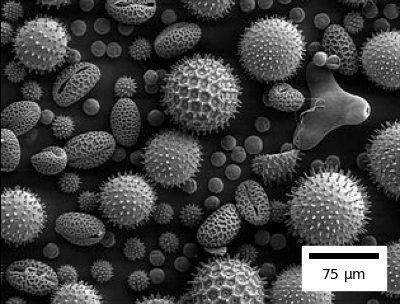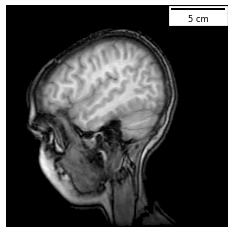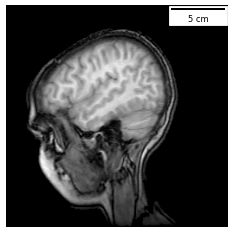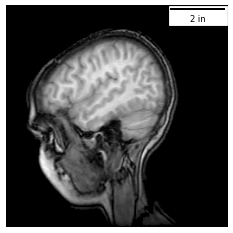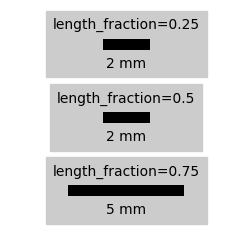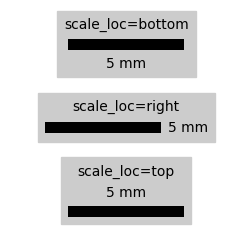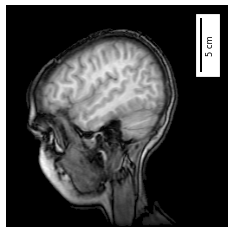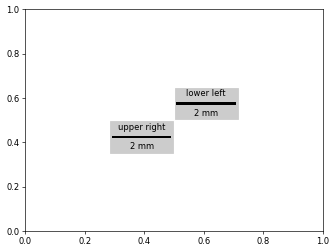Documentation: See below
Source Code: https://github.com/ppinard/matplotlib-scalebar
Cheat sheet: https://kolibril13.github.io/plywood-gallery-matplotlib-scalebar
Provides a new artist for matplotlib to display a scale bar, aka micron bar.
It is particularly useful when displaying calibrated images plotted using
plt.imshow(...).
The artist supports customization either directly from the ScaleBar object or from the matplotlibrc.
Easiest way to install using pip:
pip install matplotlib-scalebarFor development installation from the git repository:
git clone git@github.com:ppinard/matplotlib-scalebar.git
cd matplotlib-scalebar
pip install hatch
hatch env create
hatch run testThere are many ways to customize the scale bar. Examples and explanations of the arguments of the ScaleBar class are given below, but here is a quick start guide.
The constructor arguments dx and units specify the pixel dimension.
For example ScaleBar(0.2, 'um') indicates that each pixel is equal to 0.2 micrometer.
By default, the scale bar uses SI units of length (e.g. m, cm, um, km, etc.).
See examples below for other system of units.
In this example, we load a sample image from the matplotlib library, create a subplot, plot image, create scale bar and add scale bar as an "artist" of the subplot.
import numpy as np
import matplotlib.pyplot as plt
import matplotlib.cbook as cbook
from matplotlib_scalebar.scalebar import ScaleBar
# Load image
with cbook.get_sample_data("s1045.ima.gz") as dfile:
im = np.frombuffer(dfile.read(), np.uint16).reshape((256, 256))
# Create subplot
fig, ax = plt.subplots()
ax.axis("off")
# Plot image
ax.imshow(im, cmap="gray")
# Create scale bar
scalebar = ScaleBar(0.08, "cm", length_fraction=0.25)
ax.add_artist(scalebar)
# Show
plt.show()An example gallery for the matplotlib-scalebar package: https://kolibril13.github.io/plywood-gallery-matplotlib-scalebar/
Here are arguments of the ScaleBar class constructor and examples how to use them.
scalebar = ScaleBar(
dx,
units="m",
dimension="si-length",
label=None,
length_fraction=None,
height_fraction=None,
width_fraction=None,
location=None,
pad=None,
border_pad=None,
sep=None,
frameon=None,
color=None,
box_color=None,
box_alpha=None,
scale_loc=None,
label_loc=None,
font_properties=None,
label_formatter=None,
scale_formatter=None,
fixed_value=None,
fixed_units=None,
animated=False,
rotation=None,
bbox_to_anchor=None,
bbox_transform=None,
)Each argument can also be changed afterwards using their respective property.
scalebar.dx = 2.0The following schematic illustrates the nomenclature used in the definition of the arguments.
Size of one pixel in units specified by the next argument.
Set dx to 1.0 if the axes image has already been calibrated by setting its extent.
fig, ax = plt.subplots()
ax.axis("off")
ax.imshow(im, cmap="gray", extent=[0, 20.48, 0, 20.48])
scalebar = ScaleBar(1, "cm", length_fraction=0.25)
ax.add_artist(scalebar)Special notes for geospatial plots: If you are plotting geospatial coordinates (such as scatterplots of the location of structures, geopandas geodataframe plots, etc.), dx needs to be set differently depending on the coordinate system:
- For UTM based coordinate system, where the X and Y are in meters, simply set
dx = 1. - For WGS or NAD based coordinate system, where X and Y are in latitude (Y) and longitude (X), compute the distance between two points at the latitude (Y) you wish to have the scale represented and are also one full degree of longitude (X) apart, in meters. For example,
dx = great_circle_distance((X, Y), (X + 1, Y))
Units of dx.
The units needs to be valid for the specified dimension.
Default: m.
Dimension of dx and units. It can either be equal:
si-length(default): scale bar showing km, m, cm, etc.imperial-length: scale bar showing in, ft, yd, mi, etc.si-length-reciprocal: scale bar showing 1/m, 1/cm, etc.pixel-length: scale bar showing px, kpx, Mpx, etc.angle: scale bar showing °, ʹ (minute of arc) or ʹʹ (second of arc)- a
matplotlib_scalebar.dimension._Dimensionobject
fig, ax = plt.subplots()
ax.axis("off")
ax.imshow(im, cmap="gray")
scalebar = ScaleBar(0.0315, "in", dimension="imperial-length", length_fraction=0.25)
ax.add_artist(scalebar)Optional label associated with the scale bar.
Default: None, no label is shown.
The position of the label with respect to the scale bar can be adjusted using label_loc argument.
Desired length of the scale bar as a fraction of the subplot's width.
Default: None, value from matplotlibrc or 0.2.
The actual length of the scale bar is automatically determined based on the specified pixel size (dx and units) and the contraint that the scale value can only take the following numbers: 1, 2, 5, 10, 15, 20, 25, 50, 75, 100, 125, 150, 200, 500 or 750.
If you want a specific value, see fixed_value and fixed_units.
In the example below, the scale bar for a length_fraction of 0.25 and 0.5 is the same because the scale cannot have a value between 2 and 5 mm.
Deprecated, use width_fraction.
Width of the scale bar as a fraction of the subplot's height.
Default: None, value from matplotlibrc or 0.01.
A location code, same as matplotlib's legend, either: upper right, upper left, lower left, lower right, right, center left, center right, lower center, upper center or center.
Default: None, value from matplotlibrc or upper right.
Alias for location.
Padding inside the box, as a fraction of the font size.
Default: None, value from matplotlibrc or 0.2.
Padding outside the box, fraction of the font size.
Default: None, value from matplotlibrc or 0.1.
Separation in points between the scale bar and scale, and between the scale bar and label.
Default: None, value from matplotlibrc or 5.
Whether to draw a box behind the scale bar, scale and label.
Default: None, value from matplotlibrc or True.
Color for the scale bar, scale and label.
Default: None, value from matplotlibrc or k (black).
Background color of the box.
Default: None, value from matplotlibrc or w (white).
Transparency of box.
Default: None, value from matplotlibrc or 1.0 (opaque).
Location of the scale with respect to the scale bar.
Either bottom, top, left, right, none.
Default: None, value from matplotlibrc or bottom.
If "none", no scale is shown.
Location of the label with respect to the scale bar.
Either bottom, top, left, right, none.
Default: None, value from matplotlibrc or top.
If "none", no label is shown.
Font properties of the scale and label text, specified either as dict or str.
See FontProperties for the arguments.
Default: None, default font properties of matplotlib.
Deprecated, use scale_formatter.
Custom function called to format the scale.
Needs to take 2 arguments - the scale value and the unit.
Default: None which results in
scale_formatter = lambda value, unit: f"{value} {unit}"Value for the scale.
The length of the scale bar is calculated based on the specified pixel size dx.
Default: None, the value is automatically determined based on length_fraction.
Units of the fixed_value.
Default: None, if fixed value is not None, the units of dx are used.
Animation state.
Default: False
Whether to create a scale bar based on the x-axis (default) or y-axis.
rotation can either be horizontal or vertical.
Note you might have to adjust scale_loc and label_loc to achieve desired layout.
Default: None, value from matplotlibrc or horizontal.
fig, ax = plt.subplots()
ax.axis("off")
ax.imshow(im, cmap="gray")
scalebar = ScaleBar(
0.08,
"cm",
length_fraction=0.25,
rotation="vertical",
scale_loc="right",
border_pad=1,
pad=0.5,
)
ax.add_artist(scalebar)Use a different bounding box than the plot axes to anchor the scale bar.
The bbox_transform defines the transform applied to the bbox_to_anchor value.
Note that the location will influence the position of the scale bar relative to the anchor (see example below).
Default: None, the plot axes bounding box is used.
fig, ax = plt.subplots()
scalebar = ScaleBar(
1,
"cm",
length_fraction=0.25,
bbox_to_anchor=(0.5, 0.5),
bbox_transform=ax.transAxes,
location="lower left",
label="lower left",
box_color="0.8",
)
ax.add_artist(scalebar)
scalebar = ScaleBar(
1,
"cm",
length_fraction=0.25,
bbox_to_anchor=(0.5, 0.5),
bbox_transform=ax.transAxes,
location="upper right",
label="upper right",
box_color="0.8",
)
ax.add_artist(scalebar)- Fix missing
_all_deprecatedin future matplotlib (> 3.5) (#44) - Add ability to hide scale and label (#41)
- Fix deprecation warning in matplotlib >= 3.4 of
minimumdescent(#36)
- Fix scalebar location validation from rcParams (#35)
- Add rotation to display scale bar for the y-axis (#30)
- New documentation (#32)
- Deprecate argument height_fraction, replaced by width_fraction (#32)
- Deprecate argument label_formatter, replaced by scale_formatter (#32)
- Add alias loc for location (#32)
- Fix deprecation warning in matplotlib >= 3.3 of
validate_legend_loc(#33)
- Fix reciprocal unit (#29)
- Add notes about for geospatial plots (#20)
- Add angular units (#19)
- Add blit support and fix documentation (#22)
- Fix issue with getting the wrong preferred values for the scale bar (#23)
- Package LICENSE file to distribution (#24)
- Remove leftover print statement (#18)
- Add pixel unit (#12)
- Display micro symbol in text mode (#15)
- Fix error in length of scale bar; the bar was drawn with an edge around it which made it longer than the actual size (#14)
- Fix deprecated usage of is_string_like (#11)
- Add possibility to specified a fixed value for the scale bar (#9)
@maweigert, @crosbyla, @joschkazj, @AKuederle, @habi, @huangziwei, @SirJohnFranklin, @alexandrejaguar, @parishcm, @wiai, @cosmicshear, @ericore, @seangrogan, @PhilipeRLeal, @din14970, @SarthakJariwala, @k1moradi, @anntzer, @bugalo, @musicinmybrain, @kolibril13, @ilopata1
License under the BSD License, compatible with matplotlib.
Copyright (c) 2015-2023 Philippe Pinard

